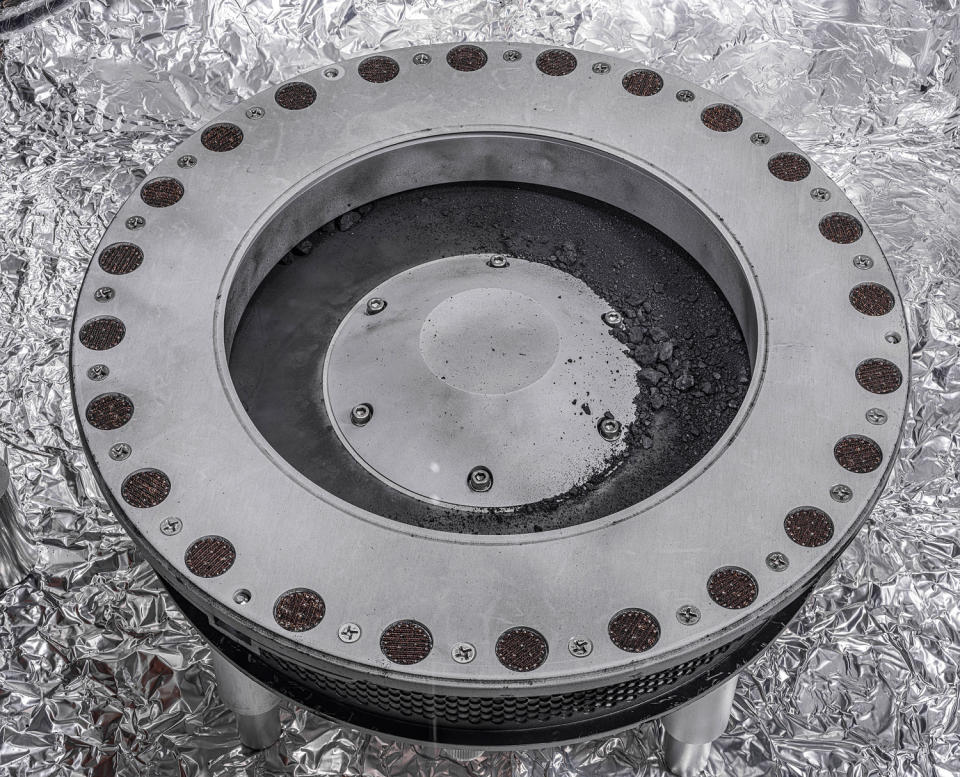NASA unveils asteroid sample that could reveal details about life on Earth
NASA revealed Wednesday that newly returned samples from a 4.5-billion-year-old asteroid contain traces of carbon and water — molecules that are thought to make up the building blocks of life.
The findings could help scientists understand how the solar system formed and how life started on Earth.
In a much-anticipated public event, the agency provided the first glimpse of the rocky samples, detailing how early studies have already yielded exciting results. The pieces of space rock contain water molecules locked up in clay minerals and are rich in carbon, according to NASA researchers.
Astrobiologist Daniel Glavin, co-investigator for the OSIRIS-REx mission that retrieved the asteroid sample, said scientists were immediately excited by the initial results.
“We picked the right asteroid. And not only that, we brought back the right sample,” he said. “This stuff is an astrobiologist’s dream.”
The samples were retrieved from the surface of a near-Earth asteroid known as Bennu, which is estimated to have formed in the first 10 million years of the solar system’s existence.

The rocks and soil are NASA's first asteroid samples brought back to Earth, and they make up the largest collection of materials gathered from a space rock. Previously, Japan's Hayabusa and Hayabusa2 missions collected and returned much smaller samples from two separate asteroids.
More research is needed to understand the rocky materials from Bennu, but the preliminary results are promising because the space rock's water and carbon content may explain how water was originally delivered to Earth.
As such, the asteroid may have played a key role in how life emerged on our planet, said Dante Lauretta, leader of the OSIRIS-REx mission and a professor of planetary sciences at the University of Arizona.
“The reason that Earth is a habitable world, that we have oceans and lakes and rivers and rain, is because these clay minerals — minerals like the ones we’re seeing from Bennu — landed on Earth 4 billion to 4½ billion years ago, making our world habitable,” Lauretta said.
The preliminary analyses were conducted on “bonus” asteroid material that was found on the outside of the main sample canister. NASA scientists have yet to unseal that internal chamber and so cannot yet confirm how much rocky material was collected from Bennu. The mission’s goal was to gather around 60 grams, or 2 ounces, of rocks and soil.
The asteroid samples are being kept in a special lab at the Johnson Space Center in Houston. More than 200 scientists around the world, including researchers at the Japan Aerospace Exploration Agency and the Canadian Space Agency, will have the chance to study the samples collected from Bennu. Some samples will be loaned out to the Smithsonian Institution, Space Center Houston and the University of Arizona for public display, according to NASA.
Agency officials also said that a portion of the samples will be preserved for study by future generations of scientists with technology that has yet to be invented.
“This material will be around for generations and generations,” Glavin said. “We’re going to learn so much about the origin of the solar system, the evolution and potentially how even life started here on Earth.”
The OSIRIS-REx spacecraft launched in 2016, traveling 4 billion miles over the past seven years to gather samples from Bennu and return them to Earth. As the probe flew by the planet last month, it jettisoned a capsule containing the precious samples, depositing it over a landing zone in the Utah desert.
The OSIRIS-REx spacecraft is now en route to another asteroid known as Apophis, which is projected to come within 20,000 miles of Earth in 2029. As part of an extended mission, the probe will study the space rock up close and make careful measurements of its orbit.
This article was originally published on NBCNews.com

